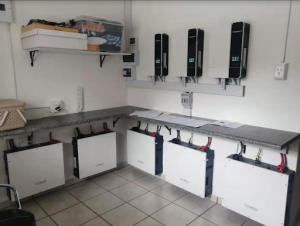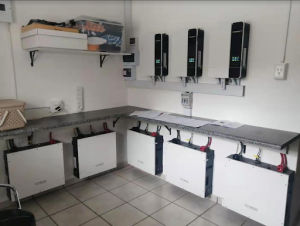Features of Dyness A48100 Lithium Battery Bank
Power Generation
Features of Dyness A48100 Lithium Battery Bank
In this article we want to introduce our readers to the new Dyness A48100 battery bank .
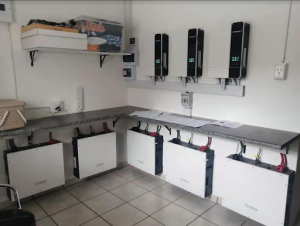
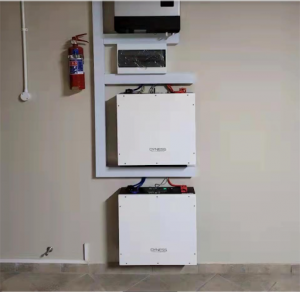
We want to talk a little bit about how to interpret the information found in the manufacturer's data sheet.
It is always interesting to talk about this equipment, as it is important to remember that the use of lithium battery banks requires some special care.
As we have already mentioned in other articles on the Solar Channel , the application of lithium batteries is different from what used to be done with lead acid batteries.
Lead acid batteries could be purchased from a variety of suppliers and could be connected to virtually any type of inverter. The user himself could form battery banks, connecting the batteries in series or parallel, according to his need.
Lead-acid batteries are currently being replaced by lithium-ion batteries, which have many advantages such as greater storage capacity and longer lifespan, with a number of charge and discharge cycles much higher than that of lead-acid batteries.
However, despite their advantages, lithium batteries need special care. They must always be accompanied by BMS (battery management system) electronic circuits, which equalize the voltage of the battery cells and monitor variables such as temperature, total bank voltage, current and state of charge.
For the proper functioning of a storage system with lithium batteries, it is necessary to make the BMS system of the battery bank talk to the inverter. Fortunately, the user rarely has to worry too much about this. The concern must occur at the time of project conception, when the components are chosen and specified.
The main battery bank manufacturers normally homologate their equipment with the main inverter manufacturers. When designing a solar energy project with storage, or simply a pure storage system, it is only necessary to verify that the desired battery bank is in the compatibility list provided by the inverter manufacturer.
In the images below, for example, we find an example of a system that uses inverters from Growatt and battery banks from Dyness. To make this combination possible, the two manufacturers talked to make their equipment compatible.
During installation, the equipment must be connected using special communication cables and the necessary adjustments must be made to the inverter and the battery bank (according to the instructions provided by each manufacturer) so that the two equipments communicate and operate safely.
Features of the A48100 battery bank
The main features highlighted by the manufacturer are:
High capacity – 4.8 kWh per unit;
Supports various installation modes: vertically, on the floor or on the wall, or with stacked units;
Possibility of expansion: the product accepts up to 40 units operating in parallel;
High security: cell-level monitoring and balancing;
Compatibility with the main inverter brands.
In the equipment data sheet we find the following table:
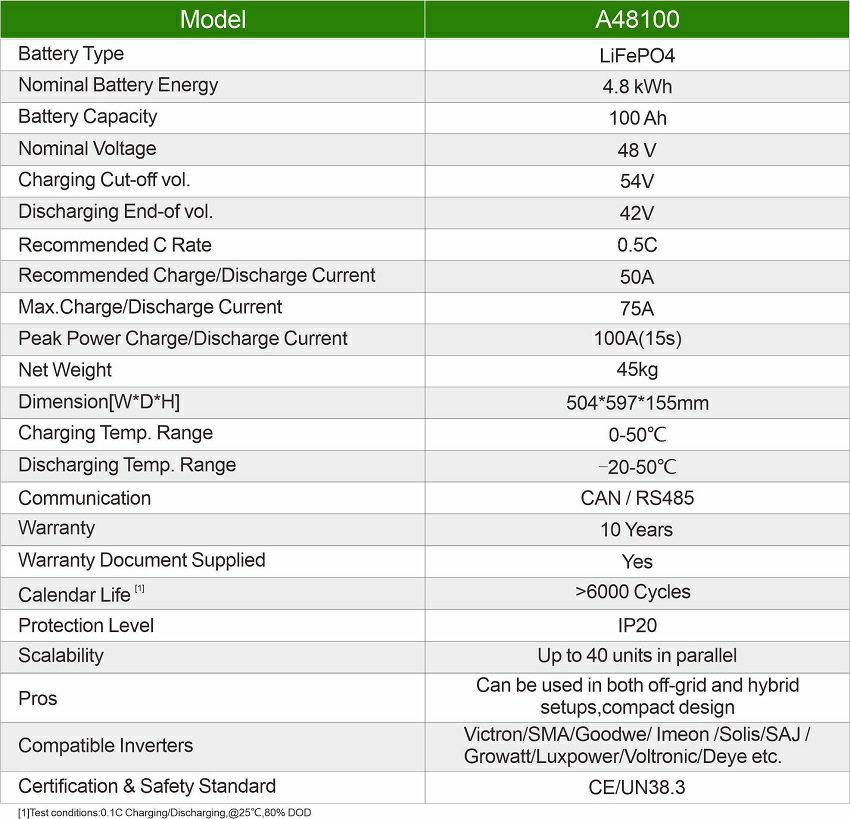
The table above shows us that the A48100 battery bank employs LiFePO4 (lithium-iron-phosphate) technology, which is one of the safest (against fire hazard) among the many existing lithium-ion battery technologies. Then, the manufacturer reports the energy storage capacity, which is measured in kWh (kilowatt hours). In this case, we have a 4.8 kWh equipment.
After the energy storage capacity, we see the charge storage capacity, which is 100 Ah. This information and the previous one are closely related, as the amount of energy a battery can store is directly related to its charge storage capacity.
It is easy to check the relationship between load and energy. The table also informs that the battery bank operates with a nominal voltage of 48 V. We know that Energy = Load x Voltage, so we have:
Load = 100 Ah
Voltage = 48 V
Power = 100 Ah x 48 V = 4,800 Wh = 4.8 kWh
Other important information is found in the table, such as the maximum charge and minimum discharge voltages, respectively 54 V and 42 V.
The charge and discharge rate, according to the table, is 0.5C. That is, if the battery has a capacity of 100 Ah and has a C-rate of 0.5C, it can be charged with a maximum current of 50 A and needs 2 hours to acquire a full charge, as 50 A x 2 h = 100 Ah. The same reasoning applies to the unloading procedure.
The table confirms the considerations in the paragraph above by informing that the maximum value of charging or discharging current recommended for this equipment is 50 A.
Despite the recommendation of a maximum rated current of 50 A, the equipment supports a peak current of up to 75 A. This means that charging and discharging must preferably occur respecting the rated current, but the equipment can deliver more power to meet consumption peaks, when this is eventually necessary.
Then, in the table, we find generic information about dimensions, weight and operating temperature, among other things. An important information is the number of cycles supported by the device: 6000. This means that the battery bank can be fully charged and discharged 6000 times.
Considering that the equipment will be fully loaded and unloaded every day (an extreme situation), the product will have a shelf life of 16 years, a very long time. As, in general, charging and discharging do not occur fully and daily in most applications, a durability of more than 16 years is expected, compatible with the life expectancy of most photovoltaic systems.
Finally, we find information about the degree of protection (IP 20, that is, the equipment cannot be exposed to rain), possibility of parallelism (40 units) and compatible inverter brands: Victron, SMA, Goodwe, Solis, SAJ, Growatt, Deye and others.



